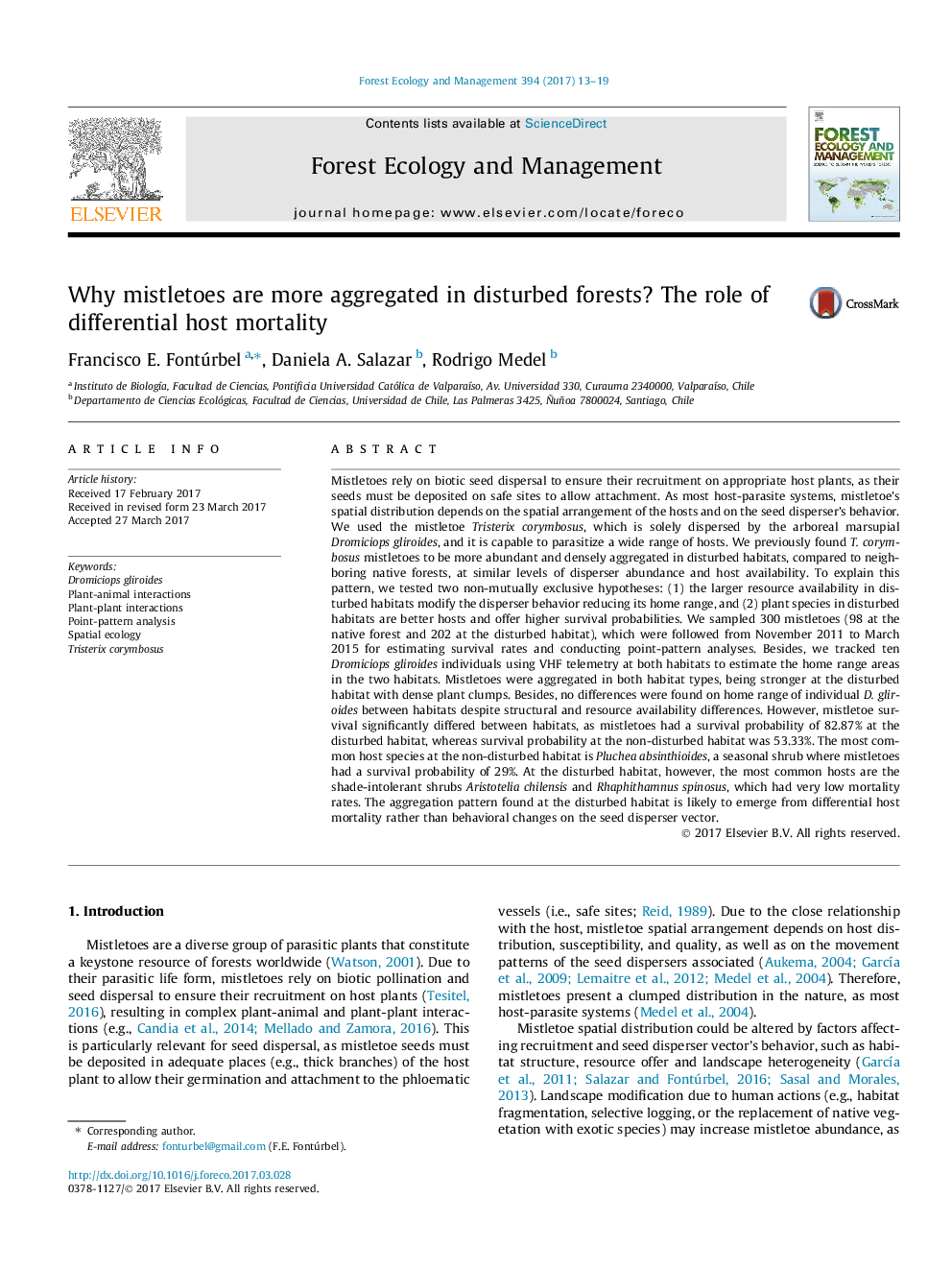| کد مقاله | کد نشریه | سال انتشار | مقاله انگلیسی | نسخه تمام متن |
|---|---|---|---|---|
| 4759445 | 1421364 | 2017 | 7 صفحه PDF | دانلود رایگان |
عنوان انگلیسی مقاله ISI
Why mistletoes are more aggregated in disturbed forests? The role of differential host mortality
ترجمه فارسی عنوان
چرا ماندگاری در جنگل های مضر بیشتر می شود؟ نقش مرگ و میر میزبان دیفرانسیل
دانلود مقاله + سفارش ترجمه
دانلود مقاله ISI انگلیسی
رایگان برای ایرانیان
کلمات کلیدی
موضوعات مرتبط
علوم زیستی و بیوفناوری
علوم کشاورزی و بیولوژیک
بوم شناسی، تکامل، رفتار و سامانه شناسی
چکیده انگلیسی
Mistletoes rely on biotic seed dispersal to ensure their recruitment on appropriate host plants, as their seeds must be deposited on safe sites to allow attachment. As most host-parasite systems, mistletoe's spatial distribution depends on the spatial arrangement of the hosts and on the seed disperser's behavior. We used the mistletoe Tristerix corymbosus, which is solely dispersed by the arboreal marsupial Dromiciops gliroides, and it is capable to parasitize a wide range of hosts. We previously found T. corymbosus mistletoes to be more abundant and densely aggregated in disturbed habitats, compared to neighboring native forests, at similar levels of disperser abundance and host availability. To explain this pattern, we tested two non-mutually exclusive hypotheses: (1) the larger resource availability in disturbed habitats modify the disperser behavior reducing its home range, and (2) plant species in disturbed habitats are better hosts and offer higher survival probabilities. We sampled 300 mistletoes (98 at the native forest and 202 at the disturbed habitat), which were followed from November 2011 to March 2015 for estimating survival rates and conducting point-pattern analyses. Besides, we tracked ten Dromiciops gliroides individuals using VHF telemetry at both habitats to estimate the home range areas in the two habitats. Mistletoes were aggregated in both habitat types, being stronger at the disturbed habitat with dense plant clumps. Besides, no differences were found on home range of individual D. gliroides between habitats despite structural and resource availability differences. However, mistletoe survival significantly differed between habitats, as mistletoes had a survival probability of 82.87% at the disturbed habitat, whereas survival probability at the non-disturbed habitat was 53.33%. The most common host species at the non-disturbed habitat is Pluchea absinthioides, a seasonal shrub where mistletoes had a survival probability of 29%. At the disturbed habitat, however, the most common hosts are the shade-intolerant shrubs Aristotelia chilensis and Rhaphithamnus spinosus, which had very low mortality rates. The aggregation pattern found at the disturbed habitat is likely to emerge from differential host mortality rather than behavioral changes on the seed disperser vector.
ناشر
Database: Elsevier - ScienceDirect (ساینس دایرکت)
Journal: Forest Ecology and Management - Volume 394, 15 June 2017, Pages 13-19
Journal: Forest Ecology and Management - Volume 394, 15 June 2017, Pages 13-19
نویسندگان
Francisco E. Fontúrbel, Daniela A. Salazar, Rodrigo Medel,
